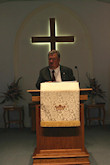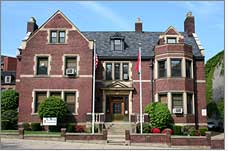 The William Penn Association was founded on February 21, 1886 in Hazleton, Pennsylvania, by thirteen Hungarian coal miners. It was chartered by the State of Pennsylvania in December of that same year under the name “Verhovay Aid Association.” WPA is one of the oldest members of the American Hungarian Federation and supports many activities aimed at preserving Hungarian American memory and culture in the United States, such as the 100th anniversary of Darr Mine Disaster Commemoration and cleanup of the local cemetery where many of the miners are buried in 2007. The William Penn Association was founded on February 21, 1886 in Hazleton, Pennsylvania, by thirteen Hungarian coal miners. It was chartered by the State of Pennsylvania in December of that same year under the name “Verhovay Aid Association.” WPA is one of the oldest members of the American Hungarian Federation and supports many activities aimed at preserving Hungarian American memory and culture in the United States, such as the 100th anniversary of Darr Mine Disaster Commemoration and cleanup of the local cemetery where many of the miners are buried in 2007.
 The goal of the founders was to extend a helping hand to each other and to the many Hungarian immigrants who worked and suffered in the mines and industrial centers of America at a period in its history when insurance of any sort was still in the far away future. With no sick benefits,no unemployment compensation, and no death benefits for their families, and with the immigrants being maimed and killed by the thousands in the ever-recurring industrial accidents, t The goal of the founders was to extend a helping hand to each other and to the many Hungarian immigrants who worked and suffered in the mines and industrial centers of America at a period in its history when insurance of any sort was still in the far away future. With no sick benefits,no unemployment compensation, and no death benefits for their families, and with the immigrants being maimed and killed by the thousands in the ever-recurring industrial accidents, t hey had no other recourse but to turn to each other for help. This is how fraternalism was born in America, and these are the same conditions that prompted the thirteen founders to establish the Verhovay Aid Association. hey had no other recourse but to turn to each other for help. This is how fraternalism was born in America, and these are the same conditions that prompted the thirteen founders to establish the Verhovay Aid Association.
After nearly four decades of growth, and with well over three hundred chapters throughout the northeastern states, in 1926 the Home Office was moved to Pittsburgh, Pennsylvania. By this time the Verhovay Aid Association had grown into the largest, wealthiest and most successful of all the Hungarian American fraternal organizations. This growth was also speeded up by mergers with a number of other smaller fraternal societies. The most significant of these  mergers included the Workingmen's Sick Benefit Federation (Munkás Betegsegélyzo Egyesület) of East Pittsburgh, Pennsylvania; the Hungarian Budapest Society (Magyar Baptista Egylet) of Cleveland, Ohio; and the Rákóczi Aid Association (Rákóczi Segélyzö Egyesület) of Bridgeport, Connecticut. The merger with the Rákóczi Aid Association in 1955 was most significant, for here two of the largest Hungarian-American fraternals came together to form the William Penn Fraternal Association to preserve and to perpetuate the Hungarian culture in America. In 1972 the name of the joint organization was changed to “William Penn Association,” which is regarded to be identical with the original Verhovay Aid Association, but also a direct descendent of the Rákóczi Aid Association founded in 1888. mergers included the Workingmen's Sick Benefit Federation (Munkás Betegsegélyzo Egyesület) of East Pittsburgh, Pennsylvania; the Hungarian Budapest Society (Magyar Baptista Egylet) of Cleveland, Ohio; and the Rákóczi Aid Association (Rákóczi Segélyzö Egyesület) of Bridgeport, Connecticut. The merger with the Rákóczi Aid Association in 1955 was most significant, for here two of the largest Hungarian-American fraternals came together to form the William Penn Fraternal Association to preserve and to perpetuate the Hungarian culture in America. In 1972 the name of the joint organization was changed to “William Penn Association,” which is regarded to be identical with the original Verhovay Aid Association, but also a direct descendent of the Rákóczi Aid Association founded in 1888.
Although by now the dominant and unrivaled Hungarian-American fraternal society, during the past decade it continued to grow by additional mergers. These included the merger with the American Life Insurance Association (Bridgeporti Szövetség) in 1979; the merger with the American Hungarian Catholic Society of Cleveland, Ohio in 1980 and the merger with the Catholic Knights of St. George of Pittsburgh, Pennsylvania in 1983. The last of these mergers was again very significant because it brought a major local fraternal society, founded nearly a hundred years earlier in 1881, into the fold of the William Penn Association.
Today the William Penn Association stands as the unrivaled major Hungarian fraternal society in America. Its goals are to provide benefits to its members and their beneficiaries; to provide housing for its elderly and disabled members; to render other fraternal services to these members and their families (including scholarships for their children); and to aid in the preservation of Hungarian culture and Hungarian ideals in this great land of America, and to do so in accordance with the goals of the Founding Fathers of both the Association and of the United States.
 While the Society exists to promote and support the study of Hungarian culture, to unite American Hungarians and to perpetuate the language of the homeland, one does not have to be of Hungarian descent to join the society. While the Society exists to promote and support the study of Hungarian culture, to unite American Hungarians and to perpetuate the language of the homeland, one does not have to be of Hungarian descent to join the society.
The William Penn Association today is headquartered in the so-called "Darlington House" on the Northside of Pittsburgh, formerly the independent city of Allegheny. It came into the possession of the William Penn Association through its 1983 merger with the Catholic Knights of St. George, an originally German Fraternal Society founded in 1881.
The builder of the mansion, Harry Darlington, was himself a self-made man, as were most of the industrial magnates of the Gilded Age. Born in Philadelphia in 1838, he moved to Pittsburgh at the age of twenty-two, where he made his fortune in beer brewing, steel, railroads, gas, and coal ventures.
He decided to have a mansion constructed in the then fashionable Allegheny City, favored by many of the new millionaires. His choice fell to the area around the meeting of Ridge Avenue and Brighton Road (709 Brighton Road), where he had a handsome brick home constructed in the early French Renaissance style. It was a highly decorated mansion with a magnificent staircase and elaborate woodwork throughout the house.
The officers of the William Penn had the Darlington House restored to its original splendor and beauty in 1983. The Darlington House now stands like a jewel among its neighbors, many of which are now part of the campus of the Community College of Allegheny County.
[Visit
The William Penn Association!] |
[< Back to Featured Members]
2009 WPA Events!
 July 18, 2009: William Penn Association Annual Scholarship Golf Outing - Pittsburgh PA...The Annual Golf Tournament is one of the most eagerly anticipated fraternal events sponsored each year by the Association. The casual atmosphere and friendly competition makes it a highly enjoyable mid-summer gathering. July 18, 2009: William Penn Association Annual Scholarship Golf Outing - Pittsburgh PA...The Annual Golf Tournament is one of the most eagerly anticipated fraternal events sponsored each year by the Association. The casual atmosphere and friendly competition makes it a highly enjoyable mid-summer gathering.
Adding to the fun each year is the putting contest held during the pre-tournament reception, the hole-in-one contest(s) for cash held during tournament play, and the auction raffle held during the golf awards banquet.
The tournament’s biggest winner each year is the William Penn Fraternal Association Scholarship Foundation, Inc. Thousands of dollars are raised during each tournament through the putting contests, hole sponsorships, Chinese Auction and raffle. [More Information]
 August 2–8 2009: Hungarian Heritage Week - William Penn Association - Rockwood, PA...As part of our commitment to promoting our Hungarian heritage, the Association sponsors a week-long Hungarian Language Camp each summer at Penn Scenic View. Each camp offers language instruction on two levels, beginner and intermediate, and is limited to a total of 25 students. August 2–8 2009: Hungarian Heritage Week - William Penn Association - Rockwood, PA...As part of our commitment to promoting our Hungarian heritage, the Association sponsors a week-long Hungarian Language Camp each summer at Penn Scenic View. Each camp offers language instruction on two levels, beginner and intermediate, and is limited to a total of 25 students.
This program continues to be successful because it offers more than just extensive language instruction. Students learn about Hungarian history, geography, culture and society. They also participate in nightly social activities at which they can practice their new language skills in a relaxed, conversational setting. [More Information]
 September 12, 2009: William Penn Annual Fraternal Fest - Rockwood, PA...The Annual Picnic is one of the Association's newest, fastest growing Hungarian fraternal events. Hundreds, and even thousands, of our members and guests from across the country gather for a day of Hungarian fellowship at Penn Scenic View in Rockwood, PA. September 12, 2009: William Penn Annual Fraternal Fest - Rockwood, PA...The Annual Picnic is one of the Association's newest, fastest growing Hungarian fraternal events. Hundreds, and even thousands, of our members and guests from across the country gather for a day of Hungarian fellowship at Penn Scenic View in Rockwood, PA.
Each year we prepare a special Hungarian menu but one thing that remains constant is that each year everyone enjoys good Hungarian food, music and dancing. Our first picnic was held on September 13, 2001 and has been an annual event since then. The success of this event has made this a Hungarian gathering that all members, both juvenile and adult, and their guests can enjoy. [More Information]

 Andy
Grove Andy
Grove
(b 1936, Budapest)
President/CEO, Chairman, and
Co-Founder of
Intel Corporation:
Time's Man of the Year for 1998. The second Hungarian awarded the honor.
The first was the Hungarian Freedom Fighter in 1957!
See more Famous Hungarians on
The
Hungary Page
Join online!

 Sign
up for the AHF mailing list. Sign
up for the AHF mailing list.
Your information is not shared!
|



